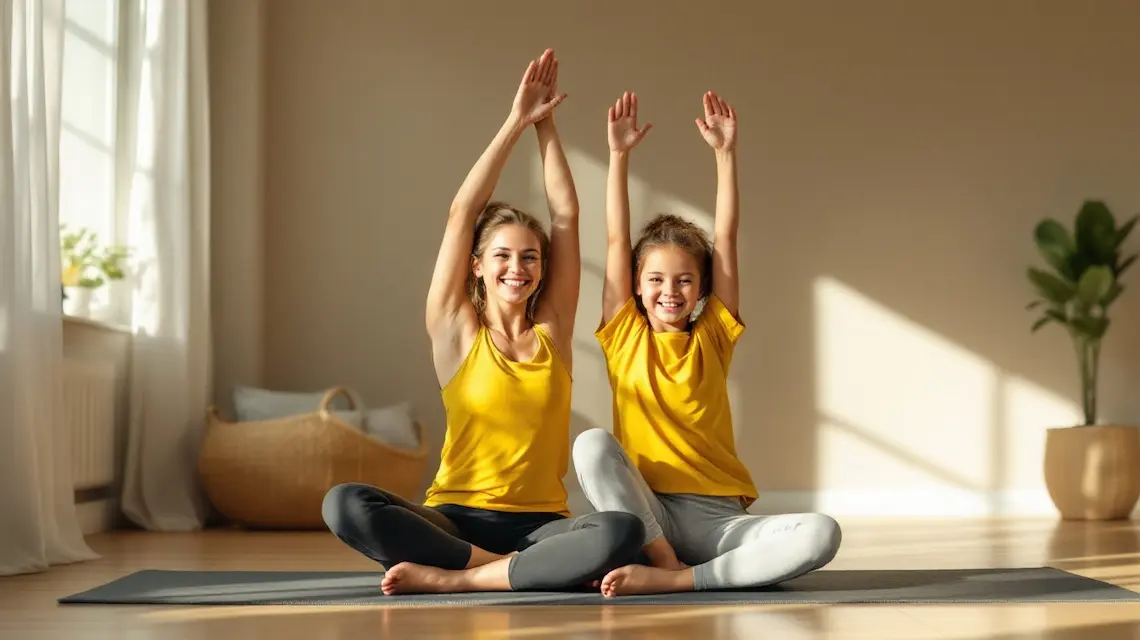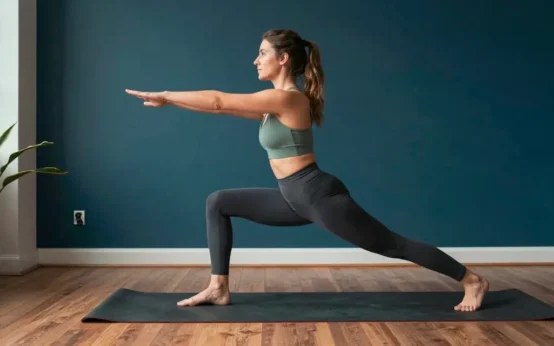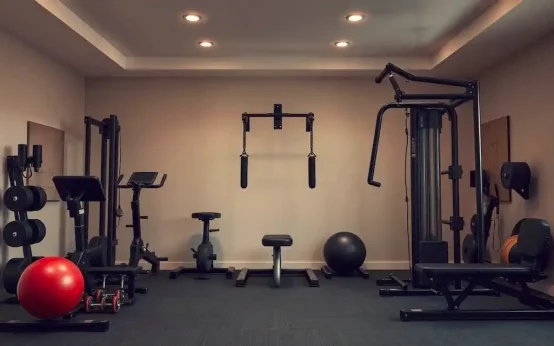Soccer practice, work emails, homework, dishes, repeat. If that sounds familiar, you’re not alone. When life stacks up, moving your body falls to the bottom of the list. That’s where exercise for kids and parents comes in, a simple way to stay active together and make it fun.
Exercising as a family trims stress, boosts mood, and builds healthy habits that stick. It helps kids burn energy and sleep better, and it helps adults gain strength and consistency. You also get built-in accountability, since your workout buddy lives with you.
This topic matters because health is a family system, not a solo job. When you move together, you model balance, teamwork, and grit. You also turn screens off, get outside more, and enjoy real face time.
In this post, you’ll get a clear look at benefits you can feel right away and over time. You’ll find fun ideas that fit busy weeknights and relaxed weekends. You’ll get simple tips to plan ahead, remove friction, and keep kids engaged.
We’ll also show you easy ways to get started today, with no gym and little gear. Think short, playful sessions, habit cues that stick, and activities that match your child’s age. By the end, you’ll have a plan that works for your home, your schedule, and your goals.
Ready to turn movement into a family routine you actually enjoy? Let’s make active time the best part of your day.
Why Exercise for Kids and Parents Strengthens Family Bonds
When you move together, you talk more, laugh more, and trust more. Shared activity creates small moments that stack up into strong connection. A family walk often leads to deeper talks. A backyard relay turns into teamwork and cheers. Exercise for kids and parents does more than build fitness, it builds a shared identity.
Fewer than 1 in 4 US kids ages 6 to 17 get the recommended 60 minutes of daily activity. Families that move together fill that gap and set a baseline for health. You also lower stress, improve communication, and build habits that can last decades.
Boosting Physical Health Together
Kids sharpen motor skills when they climb, hop, throw, and balance. These patterns form the base for all sports and playground games. Parents benefit too. Regular movement keeps energy steady, metabolism active, and joints happier.
Here is what you gain as a team:
- Heart health: Walking, biking, and tag raise heart rate in a safe way. Over time, that supports better blood pressure and endurance.
- Stronger muscles: Bodyweight moves like squats, push-ups, and carries build strength for kids and adults. Strong muscles protect joints and boost daily performance.
- Better sleep: Active bodies fall asleep faster and sleep deeper. That means fewer bedtime battles and more rested mornings.
Tie your goals to simple actions you can see. Want a confident runner at recess and a parent with steady energy? Try 15 minutes of park tag after dinner. Make it a mini tradition and track how far you can go together.
Enhancing Mental Well-Being as a Team
Movement releases endorphins that lift mood and ease anxious thoughts. Shared workouts also build family confidence. You set a plan, show up, and finish together. That rhythm teaches kids resilience and shows parents patience in real time.
- Mood boosts: A brisk walk can reset a tough day for everyone.
- Lower stress: Rhythmic movement steadies breathing and calms the nervous system.
- Confidence: Hitting small goals, like one more lap, builds belief as a family.
Use simple prompts on the move. Ask highs and lows of the day. Trade roles as leader and follower. You will notice better chats, fewer flare-ups, and a stronger sense of we.
Fun Exercise Ideas for Kids and Parents to Try at Home
Turn your living room or backyard into a simple play zone. These ideas make exercise for kids and parents feel like a game, not a chore. Pick one, set a 10 to 20 minute timer, and move together.
Energetic Indoor Games That Get Everyone Moving
Rainy day or busy weeknight, these no-equipment activities spark laughter and teamwork.
- Simon Says with Jumps: One leader calls moves like star jumps, frog hops, or lunges. Miss a “Simon says” and do five toe taps to rejoin. For ages 5 to 12. Engaging because it mixes quick thinking with big, silly moves.
- Active Charades: Act out animals, sports, or superhero poses. Add rules like three moves per clue, such as squat, spin, and freeze. For ages 5 to 12. Fun because guessing plus motion keeps everyone involved.
- Living Room Dance Party: Play a three-song playlist. Try follow-the-leader arms, high knees, and side steps. Freeze the music and hold a balance pose. For ages 5 to 12. High energy, zero setup, and tons of smiles.
- DIY Obstacle Course: Use pillows to jump, a towel to bear crawl over, and a chair to zigzag around. Time each lap and try to beat it. For ages 6 to 12 with parent setup. Engaging because kids love a challenge they can see.
Tip: Rotate leaders so every child gets a turn. That builds confidence and keeps the pace fresh.
Simple Outdoor Adventures for Active Family Time
Fresh air adds bonus energy. Keep it simple so you show up often.
- Bike rides around the block, with kids setting the route. Helmets on and use side streets for safety.
- Nature hikes on local trails. Count birds, collect leaf colors, or play “find five shapes.”
- Backyard soccer with small goals, or play keep-away to boost movement and laughs.
October weather shifts fast. Layer up with breathable shirts, light jackets, and gloves if it is chilly. Pack a dry top for post-play warmth. Shorter days need brighter colors or a small light at dusk. Keep it playful and you will stick with exercise for kids and parents all season.
Health Benefits of Regular Exercise for Kids and Parents
Regular movement pays off in ways you can feel now and see for years. Exercise for kids and parents builds strong bodies, steadier moods, and routines that protect long-term health. Think of it like compound interest, small daily choices that add up to big wins.
Supporting Growth and Development in Children
Active kids grow sturdy, coordinated, and confident. The right mix of play, strength, and aerobic activity supports their bodies and minds.
- Bone health: Jumping, hopping, and sprinting load the skeleton in a safe way. That helps build stronger bones during peak growth years.
- Weight management: Daily play balances energy in and energy out. It lowers the risk of excess weight and supports a healthy body image.
- Coordination and motor skills: Tag, climbing, and throwing sharpen balance, agility, and reaction time. These skills make sports and recess more fun.
- Immunity boost: Consistent, moderate activity helps the immune system do its job. Kids often bounce back faster from common bugs.
- Better focus and learning: Movement improves blood flow to the brain. Many kids see gains in attention, memory, and test performance.
- Social skills from group play: Team games teach sharing, turn-taking, and reading social cues. Kids practice leadership, empathy, and fair play.
Tip: Mix short bursts of running or jumping with skill work like dribbling or catching. Kids learn faster when play feels like a game.
Maintaining Adult Vitality Through Family Fitness
Parents benefit just as much. Family workouts reduce aches, build stamina, and guard against chronic issues.
- Joint pain reduction: Strength training and low-impact cardio support the muscles around hips, knees, and back. That eases stiffness and improves range of motion.
- Energy for daily tasks: Regular movement improves sleep and aerobic capacity. You feel steady energy for work, chores, and playtime.
- Stress relief: Exercise clears mental clutter and lowers tension. Shared activity multiplies the mood lift and builds patience at home.
- Prevention focus: Consistency helps manage blood pressure, blood sugar, and cholesterol. It also supports healthy weight and heart health.
- Powerful role modeling: When kids see you move, they copy you. Your routine teaches them that health is normal and non-negotiable.
Call to action: Track family progress for two weeks. Log minutes moved, steps, or a simple “smiley” for effort. Add stickers on a calendar, note weekend totals, and celebrate small wins together.
Practical Tips to Make Exercise for Kids and Parents a Daily Habit
Busy days make movement easy to skip, so keep your plan simple and flexible. Focus on consistency over intensity. Short, repeatable actions build the habit. Use these tips to make exercise for kids and parents fit your real life, not a perfect schedule.
Overcoming Common Challenges in Family Workouts
Life throws curveballs. Picky eaters, tired parents, and screen time can derail plans. The fix is to lower friction and reward effort.
- Fuel smart for picky eaters: Offer small, familiar snacks 30 minutes before activity. Try fruit, yogurt, cheese sticks, or crackers with nut butter. Keep water handy.
- Plan flexible time windows: Set a movement block, like 5 to 7 p.m., then pick a quick option that matches energy levels that day.
- Create a choice menu: List three session types, such as stretch, cardio, or strength. Kids pick one. Choice boosts buy-in and avoids arguments.
- Use micro-sessions on low-energy days: Do 2 to 3 five-minute bursts across the evening. Small chunks still count.
- Limit screens with simple rules: No screens until activity is done, or one show equals one movement session. Make it predictable.
- Build positive reinforcement: Praise effort, not outcomes. Use sticker charts, points, or a family reward jar. Trade points for small prizes or picking a weekend activity.
- Bad weather backup: Keep an indoor plan ready. Use a timer, rotate roles, and keep it short. The goal is to show up.
Tip: Put shoes and a water bottle by the door. Visual cues make it easier to start.
Setting Up a Sustainable Routine That Sticks
Start small and make it obvious. Track progress so you see the wins.
- Schedule 15 minutes a day. Anchor it to something reliable, like after dinner.
- Use a shared calendar. Color-code family sessions so they stand out.
- Involve kids in planning. Ask for ideas on music, routes, or themes.
- Track with a simple app or paper chart. Log minutes, not perfection.
- Celebrate milestones. High-fives at 7 days, a small reward at 14, a fun outing at 30.
- Keep a grab-and-go list. Include quick warmups, a short circuit, and a cooldown.
- Review weekly. What worked, what felt hard, what to tweak next.
The habit is the goal. When exercise for kids and parents shows up daily, momentum builds and the routine sticks.
Conclusion
Exercise for kids and parents builds stronger bodies, calmer minds, and closer bonds. You have simple ideas that fit real life, from indoor games to quick outdoor play. You also have practical tools, like flexible time windows, choice menus, and easy tracking, to keep the habit going.
Start small and keep it fun. Choose one activity this week, set a 15 minute timer, and show up together. Celebrate effort, rotate leaders, and let progress be the reward. When movement is a shared routine, families feel healthier, happier, and more connected.
Related post: Gentle Yoga for Beginners
Family Fitness FAQ: Practical Answers for Parents and Kids
How much exercise do kids need each day?
Kids 6 to 17 need at least 60 minutes of moderate to vigorous activity daily. Include vigorous activity, plus muscle and bone strengthening, on 3 days per week. Think running, jumping, climbing, and bodyweight moves.
How much exercise do parents need?
Aim for 150 minutes of moderate activity each week, or 75 minutes of vigorous activity. Add muscle strengthening on 2 or more days. Break it into short sessions if that fits your schedule.
Can we count chores as exercise?
Yes, if they raise heart rate or use major muscles. Raking leaves, shoveling snow, scrubbing floors, and heavy yard work count. Keep the pace brisk and set a time goal.
What are simple family workouts that fit a busy day?
Try a 20-minute walk after dinner, bike rides, or backyard soccer. Use short circuits, like 30 seconds each of squats, push-ups, jumping jacks, and planks. Turn on music and make it a quick routine.
Is strength training safe for kids?
Yes, with supervision, good form, and light to moderate loads. Bodyweight exercises, resistance bands, and medicine balls work well. Aim for 2 to 3 nonconsecutive days per week and keep reps high, weight low.
How do we warm up and cool down?
Start with 5 minutes of light movement, like brisk walking and dynamic stretches. End with 3 to 5 minutes of easy movement and gentle stretches. This helps performance and reduces soreness.
How can I keep my child motivated?
Make it fun and let your child choose the activity. Set small goals, track progress, and celebrate effort. Invite friends or family to join. Variety keeps interest high.
What if my child isn’t into sports?
Focus on play and movement, not competition. Try hiking, dance videos, martial arts, jump rope, skate parks, or geocaching. Find what feels good and build from there.
How do we handle different fitness levels in one family?
Use intervals and time-based sets so everyone works at their own pace. Offer easy and harder versions of each move. Meet at the start and finish, then regroup for a stretch.
How much screen time is okay if we’re trying to be active?
Set a daily screen plan, then protect movement time. Use screens for active sessions, like dance or workout videos. Keep phones off during family activity so it stays focused and fun.
What should kids eat before and after exercise?
Before, give a light snack with carbs and a little protein, like yogurt with fruit or peanut butter on toast. After, offer a balanced meal or snack within 1 to 2 hours, like tacos with beans and veggies or a turkey sandwich. Water beats sports drinks for most sessions under an hour.
How much water do kids and parents need during activity?
Encourage a full glass of water 30 minutes before, sips every 15 to 20 minutes during, and water after. Hot weather or hard workouts need more. Skip energy drinks for kids.
What are signs of overtraining in kids?
Watch for ongoing fatigue, trouble sleeping, mood changes, pain that doesn’t fade, or declining performance. Rest at least 1 to 2 days per week. If symptoms linger, talk with a healthcare provider.
When should kids skip exercise due to illness?
Skip if there’s a fever, vomiting, diarrhea, chest pain, or a contagious illness. Light movement is fine with a mild runny nose if they feel up to it. Return gradually when symptoms improve.
How do we exercise in bad weather or small spaces?
Use bodyweight circuits, dance, yoga, or active video workouts. Try hallway relays, stair climbs, and balance drills. Keep a small bin with a jump rope, bands, and a soft ball.
What if my child has asthma?
Follow the action plan from your provider. Warm up well, keep rescue inhalers nearby, and avoid triggers when possible. Many kids do well with swimming or interval-style activity.
How can we prevent injuries?
Use proper shoes, warm up, and increase intensity slowly. Rotate activities to avoid overuse. Pain that changes how your child moves needs rest and, if it persists, a medical check.
What’s the difference between normal soreness and an injury?
Muscle soreness peaks 24 to 48 hours after a new workout and fades. Sharp, constant, or joint pain suggests injury. Stop the activity and seek guidance if pain does not improve.
How do we set goals that stick?
Pick clear, short goals, like walking 20 minutes, 5 days this week. Track on a calendar or app and review every Sunday. Adjust the plan, not the purpose, when life gets busy.
How can we make exercise a habit as a family?
Schedule it like any other plan, same time and days. Keep gear visible, like shoes by the door and bikes ready. Start small, stay consistent, and reward the routine, not just results.
Are fitness trackers helpful for kids?
They can help some kids notice patterns and set step goals. Keep the focus on fun and energy, not numbers alone. If it causes stress, take a break from tracking.
Should kids do flexibility or mobility work?
Yes, add short mobility drills most days, like hip circles and arm swings. After activity, use gentle stretches for major muscle groups. This supports good posture and movement quality.
How do we fit exercise around homework and activities?
Use micro-workouts, like two 10-minute bursts. Walk or bike to school or practice when safe. Combine family time with movement, like a walk-and-talk instead of a sit-down chat.
What if our child wants to lose weight?
Focus on fitness, strength, sleep, and balanced meals. Avoid strict diets for kids. Build daily movement and family food habits, and let growth and health markers guide progress. If weight is a concern, consult a pediatrician or dietitian.
Where can I find trusted guidelines?
Check CDC, American Academy of Pediatrics, and the Physical Activity Guidelines for Americans. Use these to set age-appropriate goals. Then tailor the plan to your family’s needs.




 Beginner Cardio Workout at Home
Beginner Cardio Workout at Home  10 Stretching Exercises to Increase Height
10 Stretching Exercises to Increase Height  Menopause Workout: A Simple, Strong Plan
Menopause Workout: A Simple, Strong Plan  Best Home Gym Workout Equipment
Best Home Gym Workout Equipment  Exercise Tips Help You Look Great for Your Age
Exercise Tips Help You Look Great for Your Age  How to Stay Active With Back Pain
How to Stay Active With Back Pain